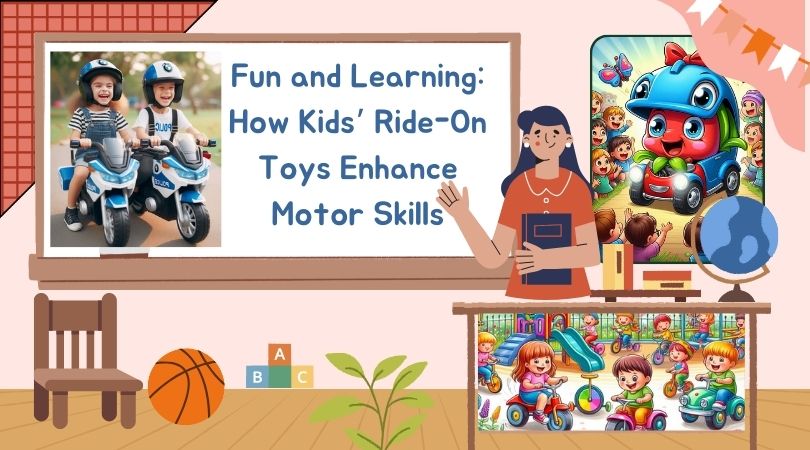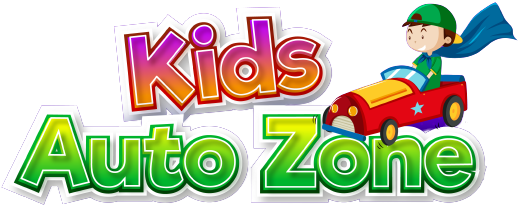
Aug 28 , 2024
Fun and Learning: How Kids’ Ride-On Toys Enhance Motor Skills
In the ever-evolving world of childhood development, the role of play in learning and skill acquisition is increasingly recognized. Among the many toys available today, ride-on toys stand out not just for their entertainment value but for their significant impact on motor skill development. These toys, ranging from electric cars to pedal-powered bikes, offer more than just fun—they play a crucial role in enhancing various aspects of a child's physical and cognitive abilities.
Understanding Motor Skills
Motor skills are divided into two categories: gross motor skills and fine motor skills. Gross motor skills involve the use of large muscle groups for movements such as walking, running, and jumping. Fine motor skills, on the other hand, involve smaller muscle groups for more precise actions, such as holding a pencil or buttoning a shirt. Ride-on toys can influence both types of motor skills, making them invaluable in early childhood development.
Gross Motor Skills Development
1. Enhancing Balance and Coordination

Ride-on toys, especially those that require pedaling or balancing, are excellent for improving a child's balance and coordination. When children navigate their ride-on toys, they must coordinate their movements to steer, accelerate, and stop. This coordination helps develop their sense of balance and spatial awareness. For instance, riding a pedal car requires children to use their legs to push the pedals while simultaneously steering with their hands, which enhances their ability to control their body movements.
2. Strengthening Muscles
Using ride-on toys involves various physical activities that strengthen muscles throughout the body. Pedaling a bike or car engages the leg muscles, while steering and maneuvering require the use of arm and core muscles. This physical exercise is crucial for developing muscular strength and endurance, which supports overall physical health and readiness for more complex physical activities as children grow.
3. Promoting Physical Endurance
Extended play with ride-on toys can improve physical endurance. As children engage in prolonged play sessions, their stamina increases, allowing them to participate in more activities without becoming easily fatigued. This enhanced endurance is beneficial for both their physical and emotional well-being, fostering a positive attitude towards physical activity and exercise.
Fine Motor Skills Development
1. Enhancing Hand-Eye Coordination

Many ride-on toys, like licensed kids electric cars, feature controls that require precise hand movements, such as steering wheels, buttons, and levers. Operating these controls helps improve hand-eye coordination as children learn to synchronize their hand movements with visual cues. For example, turning a steering wheel to navigate a path requires children to match their hand movements with their visual perception of the environment, honing their ability to control fine motor actions.
2. Developing Grip Strength
Handling the controls of ride-on toys, such as steering wheels and gear shifts, helps develop grip strength. As children grasp these controls, they improve their hand strength and dexterity, which are essential for other activities such as writing and using utensils. Stronger grip strength also contributes to better control and manipulation of objects in daily life.
3. Encouraging Cognitive Processing
Operating ride-on toys involves cognitive processes such as problem-solving and decision-making. For instance, children must think about how to navigate obstacles, make turns, and follow paths. These cognitive tasks engage the brain and contribute to the development of executive functions, which are crucial for managing multiple tasks and making informed decisions.
Cognitive and Emotional Benefits
1. Boosting Confidence and Independence
Ride-on toys provide a sense of accomplishment and independence as children master the skills required to operate them. Successfully maneuvering a ride-on toy boosts a child's confidence and self-esteem, fostering a sense of pride in their abilities. This newfound confidence can extend to other areas of their lives, promoting a positive self-image and a willingness to take on new challenges.
2. Encouraging Social Interaction
These toys are designed for group play, allowing children to interact with peers while engaging in shared activities. Playing together with ride-on toys promotes social skills such as cooperation, turn-taking, and communication. These social interactions are essential for developing interpersonal skills and learning to work as part of a team.
3. Fostering Creativity and Imagination
Ride-on toys often serve as a platform for imaginative play, where children can create their own adventures and scenarios. This imaginative play fosters creativity and problem-solving skills as children explore different roles and situations. For example, a child might pretend their ride-on car is a race car in a grand competition, enhancing their creative thinking and storytelling abilities.
Choosing the Right Ride-On Toy
1. Age Appropriateness

When selecting a ride-on toy, it is important to consider the child's age and developmental stage. Different kids toys are designed for various age groups, with specific features and safety considerations. For younger children, toys with stable bases and low speeds are ideal, while older children may enjoy more advanced options with additional features.
2. Safety Features
Safety is paramount when choosing a kids toy for riding . Look for features such as safety belts, stable construction, and reliable braking systems to ensure the child's safety during play. Additionally, check for any age-specific safety recommendations and guidelines provided by the manufacturer.
3. Quality and Durability
Investing in high-quality ride-on toys ensures that they can withstand regular use and provide long-lasting benefits. Look for toys made from durable materials and with robust construction to ensure they can handle the wear and tear of active play.
Conclusion
Ride-on toys offer much more than just fun and entertainment—they play a crucial role in enhancing motor skills, boosting confidence, and fostering social and cognitive development. By providing children with opportunities to engage in physical activity, practice coordination, and exercise their imaginations, ride-on toys contribute to a well-rounded and enriching play experience. As parents and caregivers, selecting the right ride-on toys and encouraging active play can help support children's growth and development in meaningful ways. So, let the wheels turn and the fun begin, as kids embark on their journey of learning and adventure through their ride-on toys.
